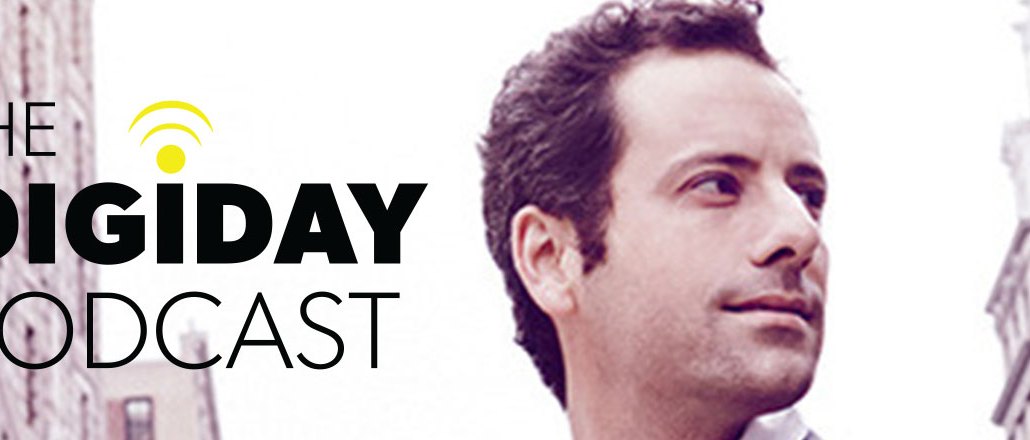BuzzFeed vet Jon Steinberg on why his new video venture Cheddar won’t rely on ads

Subscribe: iTunes | RSS |
Jon Steinberg is well-versed in the need for scale for ad-supported digital media, having served as president of BuzzFeed and CEO for North America at Daily Mail. In his new venture, a streaming video service of business news called Cheddar, Steinberg is betting on a different model: licensing fees.
By this summer, Cheddar plans to broadcast live, from the floor of the New York Stock Exchange, for the full work day. But it won’t be freely available. Cheddar instead is relying on carriage deals with the proliferating array of over-the-top providers to pay it licensing fees in order to make Cheddar available to their audiences. There will be no advertising, which means there’s no need to build gigantic audiences that was Steinberg’s focus at BuzzFeed and Daily Mail.
“I’m not going to put it out on YouTube for free and hope that $4 CPMs are my path to salvation,” Steinberg said in this week’s episode of the Digiday Podcast. “To start a standalone startup now and compete for the same mindshare and big sponsorship packages with the same 100 advertisers who buy these things, it’s too hard. I don’t want to compete against myself from five years ago.”
Starting out in advertising is hard now.
Publishers normally turn to advertising as their business model. But that’s harder than ever as the digital media world matures. Google, Facebook and a second-tier of big publishers makes competing for the attention of brand marketers difficult, especially without a track record, Steinberg said.
“If you’re not Google and you’re not Facebook, it’s really tough,” he said. “How could Cheddar walk into a room with Pepsi or P&G and say, ‘Here’s our idea for branded content, we’re going to compete with what BuzzFeed and Vox and Vice are doing?’ It would be insane.”
“There will be a shakeout among the very early-stage media companies that are now trying to do branded content,” Steinberg added. “They’re not at critical mass, they’re not at large enough scale, they haven’t built the relationships and the track record. It’s just too late.”
There will be a new crop of “cable” channels.
The collision of the Internet and TV is in full swing. There are now lots of over-the-top services, from Netflix to Amazon to Roku to Verizon, that are on the hunt for exclusive content. That means there’s a big opportunity, now and in the future, to create modern versions of Discovery Networks, Steinberg said.
“There’s a huge opportunity in creating basically cable television channels, except delivering them over the Internet,” he said. “There’s a huge market right now to sell content. All these people are building over-the-top platforms but there aren’t a lot of people programming for it. We’re going to see happen in television what happened in newspapers. It’s good if you’re going to create content at a much lower cost structure to compete with these giant cable networks.”
Live video is a big opportunity — and business news is the way in.
The whole point of digital media was originally that it allowed people to consume content whenever they want. Time-shifting was supposedly the wave of the future. Now, the pendulum has swung back to discovering the magic of live. Facebook is pushing live video, and media companies are scrambling to pump out live programming. Business news — focused on sexy companies like Amazon, Netflix and Tesla — is the best way in for live video news, Steinberg believes.
“People will continue to have TVs on their walls,” Steinberg said. “There’s very little live content for it, ambient on-the-wall content you put on to see what’s going on in the world. Given that the stock market puts up numbers all day long about which companies are doing well and which companies are doing bad, and these companies like Facebook and Snapchat and Uber are shaping our lives and are exciting, I think it’s an interesting way to program content for those screens.”
Programmatic advertising is “impossible to ‘diligence'”
Steinberg is no stranger to programmatic advertising. At Daily Mail, programmatic was an important pillar of its revenue strategy. But Steinberg finds the area needlessly complex, which naturally give rise to problems with fraud, bots and other malfeasance.
“I’m very wary of things that are impossible to diligence,” he said. “I think an educated individual should be able to spend a modest amount of time in getting a basic understanding of something. If they’re unable to, I don’t believe it’s the individual’s fault. Those things are red flags. I’ve found that no matter how much studying you do around programmatic advertising, it’s effectively impossible to ‘diligence.’ As an advertiser that would make me concerned.”
More in Media

A timeline of the major deals between publishers and AI tech companies in 2025
Here’s a list of all the major deals signed between publishers and AI tech companies in 2025.

No playbook, just pressure: Publishers eye the rise of agentic browsers
For the bulk of publishers, Google is, as ever, the one to watch. It’s already got agentic features within its Chrome browser, but that’s the tip of the iceberg, some say.

The biggest SEO lessons in 2025 for publishers
KPIs are changing, more AI search data is becoming available, and publishers are looking beyond search to grow their audiences and revenue.





